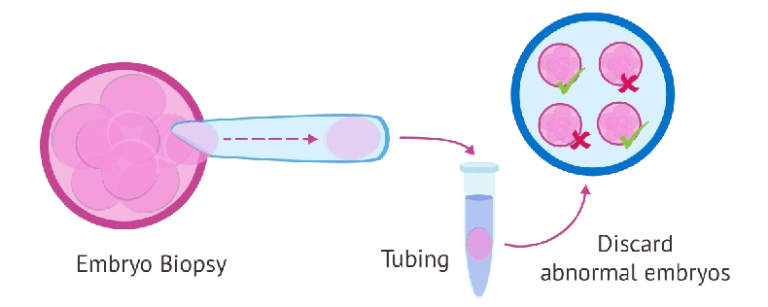Preimplantation Genetic Diagnosis
(PGD)
What Are the PGD?
Preimplantation Genetic Diagnosis (PGD)
Preimplantation Genetic Diagnosis (PGD) is one of the most advanced techniques used as part of in vitro fertilization (IVF) and intracytoplasmic sperm injection (ICSI). This optional step allows couples to screen embryos for genetic abnormalities and select the desired gender with near-perfect accuracy.
Global statistics indicate that PGD not only increases the success rates of IVF but also allows doctors to examine the genetic material of embryos, ensuring the healthiest ones are selected.
PGD also helps eliminate embryos carrying genetic disorders such as Down syndrome and hemophilia. With success rates approaching 100%, PGD is the most reliable method for gender selection.

Reasons for Gender Selection
1. Avoiding Sex-Linked Genetic Disorders
Certain genetic conditions are linked to the X chromosome, such as hemophilia and muscular dystrophy. PGD allows doctors to select embryos of a specific gender to avoid passing these conditions to the baby.
2. Family Balancing
Couples may wish to balance the number of male and female children in their family. This is especially relevant for families with limited opportunities to conceive due to maternal age or medical conditions.
3. Personal or Social Preferences
In some cultures, societal or personal preferences may influence the desire for a specific gender. PGD enables couples to fulfill these preferences responsibly and accurately.
Methods for Gender Selection
1. Timing Intercourse (Shettles Method)
Dr. Shettles proposed in the 1960s that timing intercourse relative to ovulation could influence the baby’s gender. This theory relies on the differences between X and Y chromosome-bearing sperm. However, scientific evidence supporting this method remains weak.
2. Dietary Changes
Some theories suggest that consuming certain foods high in potassium (e.g., bananas) may increase the chances of having a boy, while foods rich in magnesium (e.g., nuts) may favor having a girl. However, no conclusive scientific evidence supports these claims.
3. Personal or Social Preferences
In some cultures, societal or personal preferences may influence the desire for a specific gender. PGD enables couples to fulfill these preferences responsibly and accurately.
Frequently Asked Questions FAQ
What is PGD?
PGD (Preimplantation Genetic Diagnosis)
Is a procedure used to identify genetic conditions in embryos before implantation during IVF.
How many genetic diseases can PGD identify?
PGD can help identify over 400 genetic diseases.
What are some diseases identified through PGD?
Diseases include:
- Muscular dystrophy
- Thalassemia
- Cystic fibrosis
- Hemophilia
- Sickle cell anemia
- Von Willebrand disease
- Breast cancer genes
- Glycogen storage disease
What are the steps for gender Selection
Steps for Gender Selection
1. Ovarian Stimulation
The process begins on the second day of the woman’s menstrual cycle. Hormonal medications stimulate the ovaries to produce multiple eggs, monitored via ultrasound over 8–14 days.
2. Egg Retrieval
Under general anesthesia, eggs are retrieved using ultrasound guidance. This procedure typically lasts about 15 minutes.
3. Intracytoplasmic Sperm Injection (ICSI)
ICSI involves injecting a single sperm directly into the egg in the lab. This ensures fertilization and creates embryos for genetic screening.
4. PGD and Gender Selection
PGD screens embryos for genetic abnormalities, eliminating those carrying genetic diseases. It also identifies the embryos’ gender by analyzing their chromosomes: XX for females and XY for males.
The selected embryos are cultured for 3–5 days in ideal lab conditions before transferring the healthiest ones back into the uterus.
5. Embryo Transfer
The final step involves transferring the selected embryos into the mother’s uterus, where the pregnancy continues naturally.
